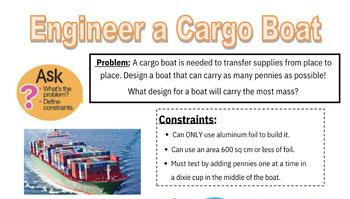Engineer a Cargo Boat: Calculating Area Applied Math STEM Challenge
- Google Drive™ folder

Description
In this engineering design STEM challenge, students will use & apply science and math concepts to their cargo boat design. This simple, yet complex, engineering design challenge will task students to build an aluminum foil boat that can hold the most amount of cargo/mass (pennies) possible. There is a constraint of the amount of aluminum foil students can use, therefore, they will have to calculate the area of a rectangle piece of foil that they choose to use to make sure it is under 600 square cm before they can build. There are also videos and resources in Google Slides to help review and learn about area, buoyancy, mass, and more. After building, students will test their boats by adding pennies into a dixie cup in the middle of the boat one by one until it sinks. They will also have to answer reflection questions, learn from other's designs, figure out how to " fail forward" and get a chance to re-design a new boat after their initial prototype. I love using this lesson toward the beginning of the year, during a science or math unit, or anytime in a STEM class.
Includes a Google Drive folder with:
- Printable or digital use PDF student engineering sheet to walk them through the engineering design process, pre-think, calculate area, collect data, and reflect on their experience.
- Google slides with videos, background information, learning targets, keywords/vocab, reflection/discussion questions, student handouts, and more.
Learning targets are:
-I can use the engineering design process to design a cargo boat prototype that is buoyant and can float.
-I can use science and math to help me solve this engineering problem.
Keywords include:
-Engineering Design Process
-Constraint
-Mass
-Buoyancy
-Prototype
-Area
I also have a bundle that includes this cargo boat challenge (area) and one that focuses on a budget. In that activity, students can use a wider variety of materials other than aluminum foil to construct their boat and must stay under a certain budget. I usually do this lesson first, and then that challenge next.
I have used this with 2nd-6th graders and all have loved this challenge, hope you do too! I currently use it with my 4th grade innovation and STEM class!





